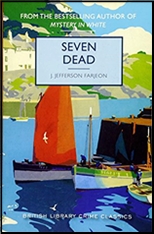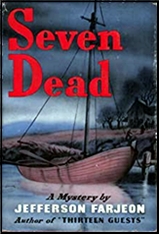Sat 30 Jul 2022
A Mystery Review by David Vineyard: J. JEFFERSON FARJEON – Seven Dead.
Posted by Steve under Reviews1 Comment
J. JEFFERSON FARJEON – Seven Dead. Inspector Kendall #3. Collins, UK, hardcover, 1939. Bobbs-Merrill, US, hardcover, 1939. Poisoned Pen Press / British Library Crime Classics, US, trade paperback, 2018.

When journalist and yachtsman Thomas Hazeldean who has come ashore to post a letter spots Ted Lyte fleeing from a house on a remote part of the coast he and a constable catch him with silverware in his pockets, but Lyte is uncommunicative.
Something has scared the wits out of him.
They take him to police headquarters where Detective Inspector Kendall is on duty. A few inquiries prove that Haven House where the Fenners live has been mysteriously quiet for some time and no calls have gone through though several have been made. Kendall resolves to find out why and with two constables, a police doctor, and Hazeldean in tow goes to investigate.
Here there is a nice bit of a jump scare involving the “howler,†an intrusive device the phone service has to notify customers a call is being made to them.
What they find is six men and a woman in man’s clothes (“She might have been attractive once. She was not now.â€), all roughly dressed, all obviously worse for wear, and all dead.
The doctor can’t say from what, though they have been dead too long to have been Ted Lyte’s work. Mysteries abound, including a painting of a young girl with a bullet hole in it, a gun fired one time, a dirty cricket bat on the mantle where a clock had stood, a dead cat outside, rubber tubing, a mysterious underground work shop that smells strange, and a note with an odd address that says the Suicide Club on the other side.
Hazeldean makes for an attractive and believable co-sleuth who actually contributes to Kendall’s job as the two, apart and together, pursue answers to what happened. Why would seven strangers come to an empty house, the owners are away, and kill themselves, if it was suicide? Who are they, how did they come, and what is the meaning of their dirty worn clothing, the men are dressed like sailors, and emaciated looks. What ordeal did they face before killing themselves or being murdered?

Joseph Jefferson Farjeon, who also wrote as Anthony Swift, was a popular writer from a distinguished family who penned several books with Kendall as sleuth and even more about Ben the Tramp, a charming hobo who sometimes assists Scotland Yard. His books were admired by Dorothy L. Sayers, and it isn’t hard to see why. His characters are and smart and attractive, his plots move swiftly, his murders are less contrived and more natural than they first seem, his criminals kill for believable motives, and even when he throws in a romance (as he does here) it is between attractive and likable people the readers cares about.
In an era where bright young things could be an absolute pain to deal with in an otherwise good mystery novel Farjeon manages to keep them attractive and this side of believable. Hazeldean becomes fascinated by the girl whose picture has a bullet hole (who proves to be Dora Fenner, the now grown daughter of the owner, shades of Laura) in it, and follows a clue across the Channel to Boulogne where more mystery awaits.
Seven Dead gives us a classic Golden Age puzzle, good dialogue and by play between Hazeldean and Kendall, the latter smart without being unlikely (as Hazeldean says, “…he didn’t play the violin or have a wooden leg or something…,†and only a shade acerbic in an attractive way, and more importantly a reasonable solution that ends in a nice bit of melodrama that nevertheless develops from the plot and characters and doesn’t strain credibility.
It doesn’t hurt that Farjeon isn’t afraid to throw in thriller and adventure elements and blend them with the puzzle (he wrote several good chase novels too, including one filmed by Alfred Hitchcock, Number 17), meaning his books often seem less dated and formal than many of the greater lights of the genre. I suppose for some that is a drawback, but for this reader it is a definite plus.
The British Library Crime Classics version of this has a fine introduction by Martin Edwards and an attractive cover and is available reasonably. All the Ben the Tramp books are available currently and several of Farjeon’s others, and all the ones I’ve read have been entertaining, though not necessarily classics.
He’s not another Christie or Sayers, but he is great fun to read which isn’t always true of writers from his era. His books are old fashioned enough to fill that bill while written in a straight forward modern enough style not to leave the reader gritting his teeth, for a solid fast entertaining mystery novel of the era you could do a lot worse than Farjeon.
July 31st, 2022 at 8:16 am
My review of Farjeon’s MYSTERY IN WHITE can be found here:
https://mysteryfile.com/blog/?p=44128
It’s another of his mysteries that’s been reprinted as a British Library Crime Classic. My comments are rather mixed, and in fact more so than I remembered just before I went looking for it. (I remembered it as mostly positive.)
Not really a lost classic, I said, but certainly a lot of fun to read.